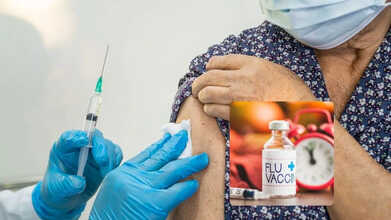- Health Conditions A-Z
- Health & Wellness
- Nutrition
- Fitness
- Health News
- Ayurveda
- Videos
- Medicine A-Z
- Parenting
- Web Stories
Monsoon Health Guide: How To Prevent UTIs During The Rainy Season

Urinary infection symptoms (Credit: Canva)
The monsoon season offers a much-needed reprieve from the scorching heat, but it also brings along its own set of health concerns. One of the most prevalent health issues during this season is urinary tract infections (UTIs), which disproportionately affect women. Increased humidity, coupled with unhygienic conditions, creates the ideal environment for bacterial growth, making UTIs a common occurrence. However, with proper hygiene and awareness, UTIs and other urological problems can be effectively prevented.
Why Are UTIs More Common During Monsoon?
The increased moisture and humidity during monsoon create the perfect breeding ground for bacteria. This is exacerbated by the frequent use of unclean public restrooms, improper intimate hygiene, and wearing tight-fitting or synthetic clothes. Dr. Bandi explains that these conditions create an environment conducive to bacterial growth in the genital area, increasing the risk of infection.
Women are more prone to UTIs than men, particularly because of anatomical differences. The urethral opening in women is situated closer to the anal opening, making it easier for bacteria to migrate from the rectal area to the urinary tract. Additionally, women have a shorter urethra, which allows bacteria to reach the bladder more easily.
The use of scented or alcohol-based products around the genital area, as well as the prolonged use of sanitary napkins or tampons, further increases the risk of UTIs. Women need to be vigilant, especially during the monsoon, to maintain proper hygiene and reduce their chances of infection.
Recognizing the Symptoms of UTIs
A urinary tract infection typically begins with,
- discomfort while urinating, often described as a burning sensation
- followed by pain in the lower abdomen and around the urethral opening
- increased urge to urinate, often in small quantities, and difficulty controlling the urge
In more severe cases, symptoms may include chills and fever. If left untreated, a UTI can travel up the urethra and affect the kidneys, leading to more serious complications.
Women who are pregnant, menopausal, or diabetic are especially vulnerable and should seek medical attention if they notice any early signs of infection.
How to Avoid UTIs During Monsoon
Preventing UTIs during monsoon is not difficult if you follow a few essential steps:
- Drink plenty of water throughout the day. Hydration helps flush out bacteria from the urinary tract, reducing the risk of infection.
- Always clean the genital area properly after using the restroom, wiping from front to back to avoid the transfer of bacteria.
- Avoid staying in wet clothes for extended periods, as moisture can contribute to bacterial growth.
- Whether you're using sanitary napkins or tampons, ensure that you change them every 3–4 hours to avoid infection.
- Always urinate after sexual activity to help flush out any bacteria that may have entered the urethra.
If symptoms persist despite these precautions, it's essential to consult a healthcare professional for proper diagnosis and treatment.
Other Urological Diseases
While UTIs are more common during the monsoon, they are not the only urological issues that can arise. A range of urological problems can affect both men and women, especially during the humid season.
1. Benign Prostatic Enlargement (BPE)
Men, particularly older individuals, are at risk of benign prostatic enlargement (BPE). This condition occurs when the prostate gland enlarges, causing symptoms such as difficulty initiating urination, frequent urges to urinate, and an inability to completely empty the bladder. Treatment may include medications or, in severe cases, surgery.
2. Kidney Stones
Kidney stones are another common urological issue. These hard deposits form in the kidneys and can cause intense pain when they move into the ureter. While small stones may pass on their own, larger ones may require surgical removal. It is crucial to stay hydrated and follow dietary guidelines to prevent the formation of kidney stones.
3. Hematuria
Hematuria, or blood in the urine, can signal a range of underlying issues, from urinary tract infections to more severe conditions like urinary tract cancers. If you notice blood in your urine, consult a doctor immediately for further evaluation.
4. Urinary Incontinence
Urinary incontinence, or the involuntary loss of bladder control, can affect both men and women. Causes can include pregnancy, childbirth, an enlarged prostate, or neuromuscular problems. Depending on the severity, treatment options range from lifestyle changes to surgical intervention.
Monsoon health concerns, especially urinary tract infections, require vigilance and proper hygiene. Don’t hesitate to consult a healthcare professional if symptoms persist, as timely intervention can prevent more serious complications.
Disclaimer: The information provided in this article is for general informational purposes only and should not be considered as medical advice. Always consult with a qualified healthcare professional or your doctor before starting any treatment or if symptoms persist.
Fact Check: Does Cracking Your Knuckles Every Day Damage Your Joints?

Credits: Canva
If you are someone who cracks your knuckles every day just for that oddly satisfying pop, you are not alone. For many, the sharp sound brings a fleeting sense of relief or relaxation. Yet, there has long been a debate about whether this seemingly harmless habit could actually damage your joints or raise the risk of arthritis.
For those unversed, the pop you hear when cracking your knuckles comes from gas bubbles in the joint fluid collapsing. For most people, it’s harmless, though it can occasionally cause slight swelling or a temporary drop in grip strength. The long-standing belief that it leads to arthritis is not backed by science, but using too much force could result in minor injuries, like ligament sprains or dislocations
Addressing this common worry, orthopedic surgeon Dr. Manan Vora answered the question in a viral reel that has now surpassed 2.5 million views. A viewer asked him, “Can cracking knuckles every day lead to arthritis?”
Dr. Vora said, “The pop you hear when cracking a knuckle is the sound of these bubbles bursting within the synovial fluid inside the joint,” he clarified.
Is Cracking Knuckles Bad For You?
Knuckle cracking is a habit many pick up early in life, often because they enjoy the sound or the temporary feeling of looseness in the fingers. According to the Johns Hopkins Arthritis Center, the sound comes from changes inside the joint capsule, which is filled with synovial fluid. This fluid not only lubricates the joints but also nourishes the surrounding bones.
“A variety of gases are dissolved in this fluid. When a knuckle is cracked, stretching the capsule lowers the pressure inside, creating a vacuum. The dissolved gases form a bubble, which bursts, producing the familiar popping sound. It takes time for the gases to re-dissolve, which is why you can’t immediately crack the same knuckle again,” Johns Hopkins adds.
Does Cracking Knuckles Cause Arthritis?
Many worry that frequent knuckle cracking could trigger arthritis. However, research shows there is no evidence linking the habit to arthritis or long-term joint damage. A few reports have noted that excessive cracking may occasionally cause minor ligament strains or tendon dislocations, but these injuries typically heal on their own.
Some studies also suggest that habitual knuckle crackers might have slightly reduced grip strength over time, but this does not equate to arthritis. Rarely, “knuckle pads” can develop in young people who crack their knuckles often, but these are mostly cosmetic.
Several studies back up the conclusion that knuckle cracking does not cause arthritis. For example, a study by the Uniformed Services University of the Health Sciences followed 215 participants, 20% of whom regularly cracked their knuckles. They found arthritis in 18.1% of knuckle crackers and 21.5% of non-crackers, essentially the same rate, showing no link between the habit and the disease.
A famous anecdote comes from Dr. Donald Unger, who cracked the knuckles on his left hand twice daily for 50 years while leaving his right hand untouched. Published in Arthritis and Rheumatism in 1998, the informal experiment revealed that neither hand showed signs of arthritis. More recent studies in 2017 reached similar results, finding no difference in hand function between people who cracked their knuckles and those who didn’t.
What Is Arthritis?
Arthritis is a condition that causes inflammation and pain in one or more joints, often leading to stiffness and limiting the joint’s range of motion. Genetics play a major role, with environmental triggers contributing to inflammatory types, and age or mechanical stress driving degenerative arthritis.
Other risk factors include obesity, previous joint injuries, family history, older age, and being female. But as research confirms, knuckle cracking is not one of them.
Do You Have Persistent Nasal Congestion? It Could Be A Sign of Long Covid

Credits: Canva
A symptom that most people associate with a common cold could actually indicate long Covid. Typically, individuals recover from a coronavirus infection within a few weeks after symptoms begin. However, NHS guidance points out that some people can develop a more persistent illness, with symptoms lasting far longer.
Long Covid, also called post-COVID syndrome, is usually diagnosed when COVID-19 symptoms persist for more than 12 weeks. Keep reading to learn which common symptom might actually be a sign of long Covid.
One Nose Symptom That Can Also Be Long Covid
Long Covid symptoms can vary widely, and many may be mistaken for a regular cold or flu. For instance, a sore throat or a runny nose could suggest either a common cold or long Covid, depending on how long the symptom has been present.
What Are Common Symptoms Of Long Covid
Other symptoms may include:
- Memory or concentration difficulties, often referred to as brain fog
- Shortness of breath
- Joint aches and muscle pain
- Extreme fatigue
- Hair loss or skin rashes such as hives
- Nasal congestion or a runny nose
- Headaches, dizziness, or vertigo
- Pins and needles or widespread body aches
- Persistent cough
- Abdominal pain or diarrhoea
- Nausea, vomiting, weight loss, and reduced appetite
- Trouble sleeping (insomnia)
- Elevated temperature
- Changes in senses, including vision issues, earaches, tinnitus, or altered taste and smell
- Anxiety and depression
- Sore throat
- Sudden confusion (delirium), especially in older adults
- Chest pain or tightness, and noticeable heart palpitations
How To Know If You Have Long Covid Or Common Cold?
Telling the difference between a common cold and COVID-19 can be tricky, as many symptoms overlap. You can look for clues such as when the symptoms started, the intensity of fatigue, and whether you have experienced loss of taste or smell, a hallmark of earlier COVID variants. The only way to be sure is to take a COVID-19 test.
Long Covid stands apart from both a cold and acute COVID-19 because its symptoms, like fatigue, shortness of breath, and cognitive difficulties, persist for weeks or months after the initial infection.
Long Covid Complications
Some people, particularly those who had severe COVID-19, may experience effects on multiple organs or develop autoimmune conditions lasting weeks, months, or even years. These multi-organ effects can involve the heart, lungs, kidneys, skin, and brain. Many of these complications share symptoms with commonly reported long Covid issues. Consequently, people who have had COVID-19 may be at higher risk of developing or worsening conditions such as:
- Diabetes
- Heart problems
- Blood clots
- Neurological disorders
If you suspect you have long Covid, your GP may run several tests to rule out other causes of your symptoms, including blood tests. They might also monitor your heart rate and oxygen levels.
In some cases, further investigations such as an ECG or X-ray may be required. Some patients may be referred to a team of specialists at a post-COVID syndrome clinic for comprehensive evaluation.
Thinking Of Getting Your Flu Shot? NHS Says ‘Wait’ If You Have This One Symptom

Credits: Canva
As the crisp autumn air settles in, flu season returns, bringing the familiar symptoms of fever, and cough. Each year, influenza , commonly known as the flu, impacts millions of people. For most, it causes a mild to moderate illness, but for some, it can be serious, potentially leading to hospitalization or even death.
Even though the onset of flu season may feel routine, it is crucial to remember that the virus evolves annually, making yearly vaccination an essential measure for staying healthy. That said, the NHS has advised delaying your autumn vaccination if you experience one specific symptom. The health service advises that you should “wait until you’re feeling better” before getting the flu jab.
NHS Flu Vaccination
The flu shot is offered on the NHS every year during autumn or early winter for individuals at higher risk of severe flu complications. Those eligible include people aged 65 and over, as well as those with certain long-term medical conditions. According to the NHS website, the vaccine protects against the “most common types” of flu strains each year. While it’s still possible to catch the flu after vaccination, symptoms are generally milder and shorter in duration.
One Symptom That Means You Should Postpone Your Flu Jab
This year’s autumn and winter vaccination program is underway, with appointments available through GP practices, the NHS app, and select pharmacies. However, there are circumstances in which vaccination should be delayed. The NHS recommends: “If you have a high temperature, wait until you’re feeling better before having your flu vaccine.”
Some individuals may also be at risk of allergic reactions to the injection. “Most people eligible for the flu vaccine can receive it,” the NHS confirmed, adding: “You should not get the vaccine only if you’ve had a severe allergic reaction (anaphylaxis) to a previous dose or to an ingredient in the vaccine.” Some flu vaccines in the UK contain egg protein, so anyone with an egg allergy should inform the healthcare professional administering the shot.
Side Effects Of The Flu Vaccine
The NHS notes that side effects are typically mild and usually resolve within one to two days. These can include:
- Pain or soreness at the injection site
- A slightly raised temperature
- Aching muscles or body
The NHS clarifies: “The injected flu vaccines used in the UK do not contain live viruses. They cannot give you flu.”
Flu shots can generally be given alongside other vaccines, such as COVID-19 or shingles vaccines. They are not usually administered with the RSV vaccine, though simultaneous vaccination may be advised if a doctor or nurse deems it appropriate.
Eligibility For Flu Vaccine
Flu vaccines are recommended for everyone aged six months and older, with a focus on high-risk groups such as children under five, adults 65 and older, pregnant women, and those with chronic health conditions. Individuals who have previously had a severe allergic reaction to a flu vaccine should consult a healthcare provider before receiving the shot.
Recent updates to vaccine policies, particularly around COVID-19 vaccines, have caused some confusion. Many wonder if getting the flu jab has become more complicated. The good news is that flu vaccines remain widely accessible. Pharmacies, GP offices, public health clinics, and many workplaces continue to offer the seasonal injection, often at little or no cost.
© 2024 Bennett, Coleman & Company Limited

